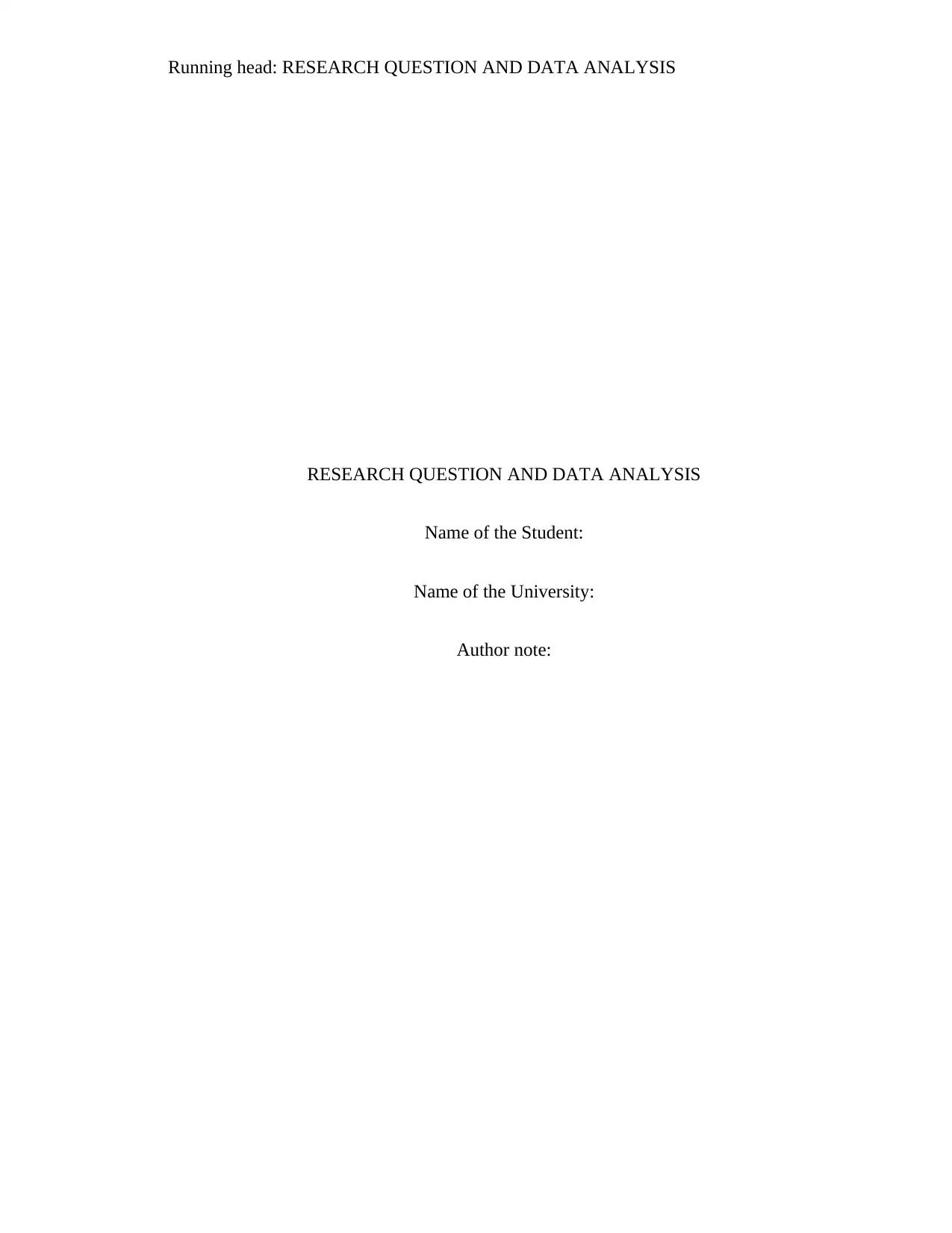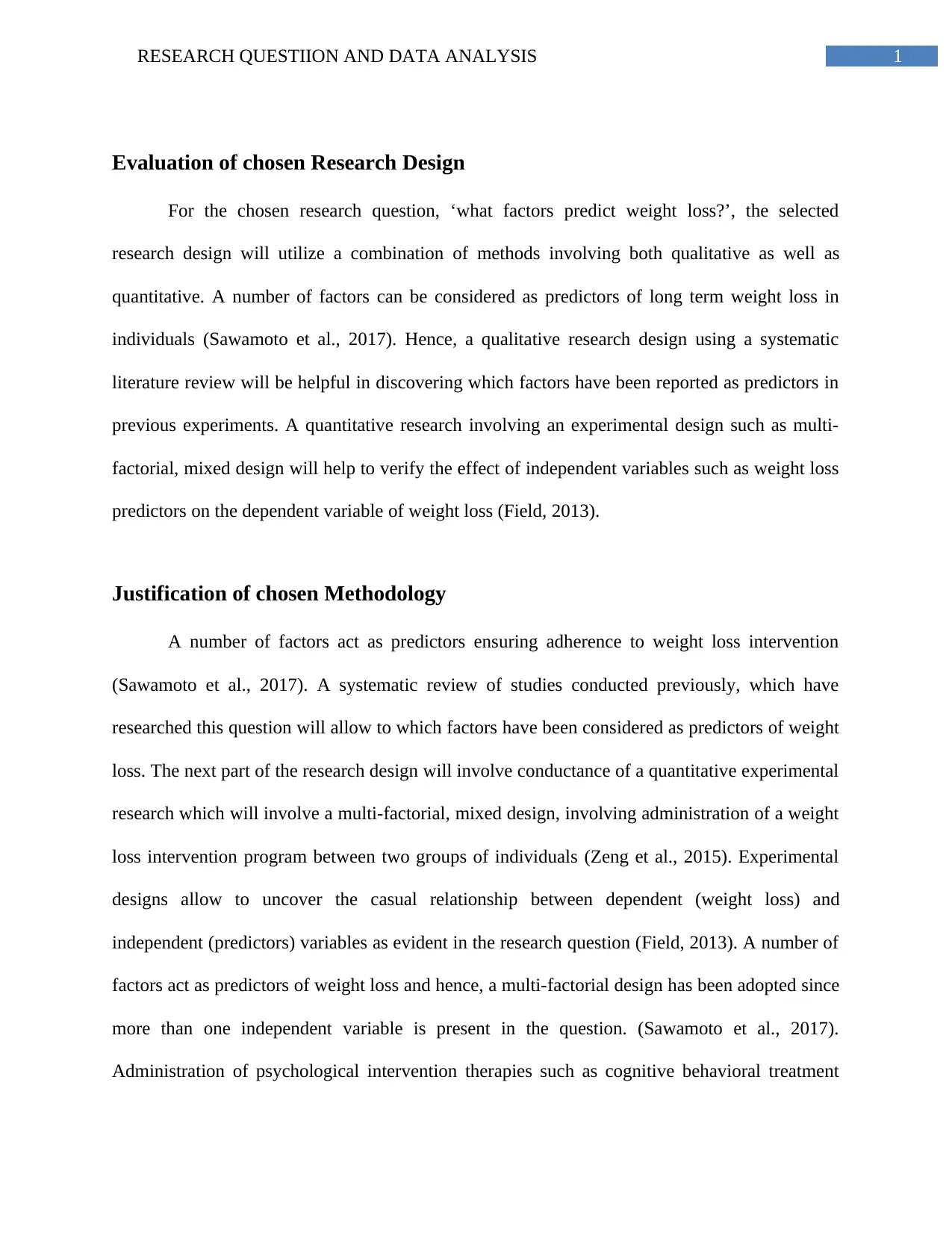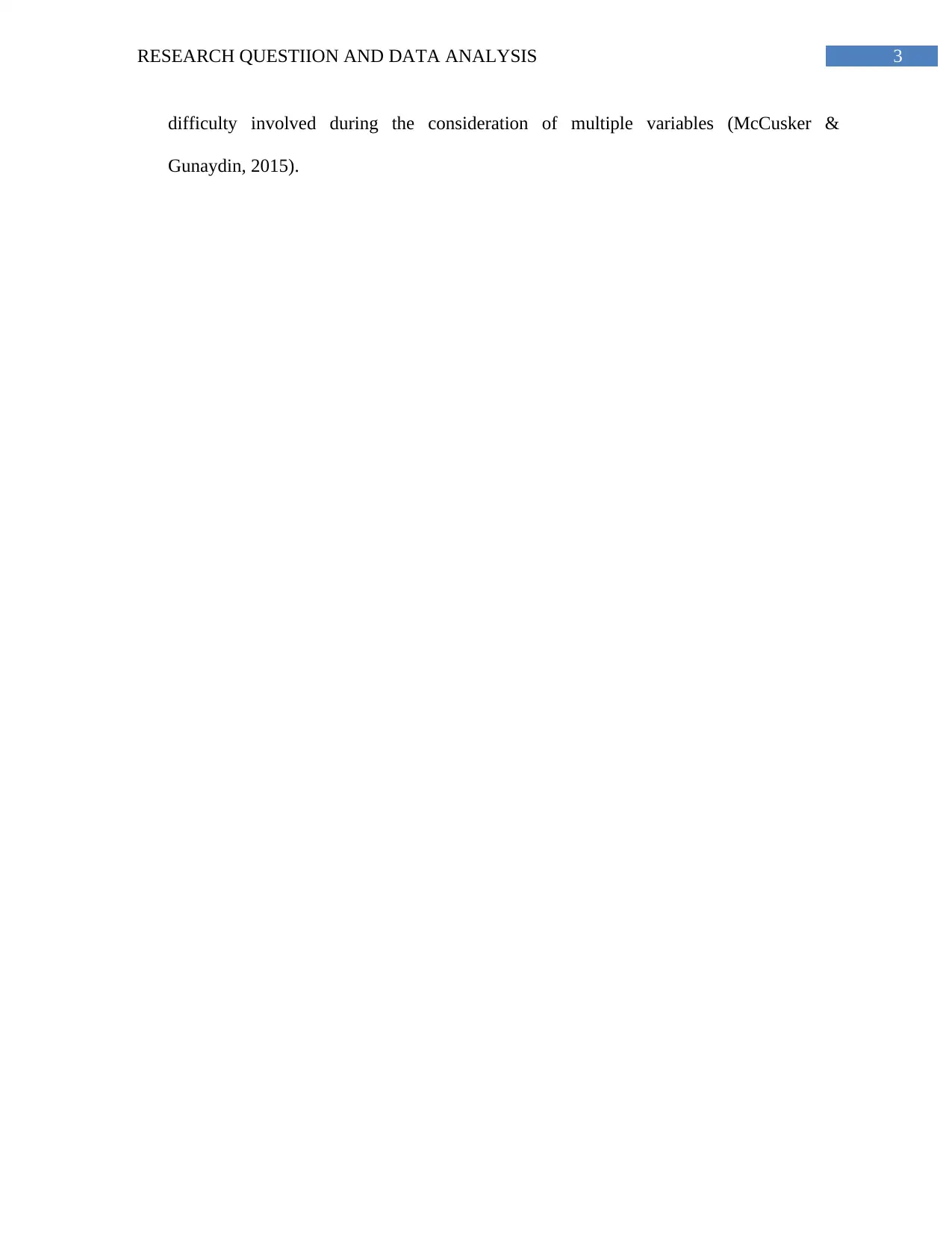Evaluation of Research Design: Factors Predicting Weight Loss Analysis
VerifiedAdded on 2023/04/20
|5
|848
|114
Report
AI Summary
This report evaluates a research design aimed at understanding the factors that predict weight loss. The design incorporates both qualitative and quantitative methods. A systematic literature review is proposed to identify factors reported as predictors of weight loss, while a quantitative exp...

Running head: RESEARCH QUESTION AND DATA ANALYSIS
RESEARCH QUESTION AND DATA ANALYSIS
Name of the Student:
Name of the University:
Author note:
RESEARCH QUESTION AND DATA ANALYSIS
Name of the Student:
Name of the University:
Author note:
Paraphrase This Document
Need a fresh take? Get an instant paraphrase of this document with our AI Paraphraser

1RESEARCH QUESTIION AND DATA ANALYSIS
Evaluation of chosen Research Design
For the chosen research question, ‘what factors predict weight loss?’, the selected
research design will utilize a combination of methods involving both qualitative as well as
quantitative. A number of factors can be considered as predictors of long term weight loss in
individuals (Sawamoto et al., 2017). Hence, a qualitative research design using a systematic
literature review will be helpful in discovering which factors have been reported as predictors in
previous experiments. A quantitative research involving an experimental design such as multi-
factorial, mixed design will help to verify the effect of independent variables such as weight loss
predictors on the dependent variable of weight loss (Field, 2013).
Justification of chosen Methodology
A number of factors act as predictors ensuring adherence to weight loss intervention
(Sawamoto et al., 2017). A systematic review of studies conducted previously, which have
researched this question will allow to which factors have been considered as predictors of weight
loss. The next part of the research design will involve conductance of a quantitative experimental
research which will involve a multi-factorial, mixed design, involving administration of a weight
loss intervention program between two groups of individuals (Zeng et al., 2015). Experimental
designs allow to uncover the casual relationship between dependent (weight loss) and
independent (predictors) variables as evident in the research question (Field, 2013). A number of
factors act as predictors of weight loss and hence, a multi-factorial design has been adopted since
more than one independent variable is present in the question. (Sawamoto et al., 2017).
Administration of psychological intervention therapies such as cognitive behavioral treatment
Evaluation of chosen Research Design
For the chosen research question, ‘what factors predict weight loss?’, the selected
research design will utilize a combination of methods involving both qualitative as well as
quantitative. A number of factors can be considered as predictors of long term weight loss in
individuals (Sawamoto et al., 2017). Hence, a qualitative research design using a systematic
literature review will be helpful in discovering which factors have been reported as predictors in
previous experiments. A quantitative research involving an experimental design such as multi-
factorial, mixed design will help to verify the effect of independent variables such as weight loss
predictors on the dependent variable of weight loss (Field, 2013).
Justification of chosen Methodology
A number of factors act as predictors ensuring adherence to weight loss intervention
(Sawamoto et al., 2017). A systematic review of studies conducted previously, which have
researched this question will allow to which factors have been considered as predictors of weight
loss. The next part of the research design will involve conductance of a quantitative experimental
research which will involve a multi-factorial, mixed design, involving administration of a weight
loss intervention program between two groups of individuals (Zeng et al., 2015). Experimental
designs allow to uncover the casual relationship between dependent (weight loss) and
independent (predictors) variables as evident in the research question (Field, 2013). A number of
factors act as predictors of weight loss and hence, a multi-factorial design has been adopted since
more than one independent variable is present in the question. (Sawamoto et al., 2017).
Administration of psychological intervention therapies such as cognitive behavioral treatment

2RESEARCH QUESTIION AND DATA ANALYSIS
(CBT), act as motivational predictors of weight loss and hence, the quantitative section of this
research design will involve an experimental group receiving CBT and a control group not
receiving CBT prior to weight loss treatment, will allow us to understand whether presence of
external interventions like the above, modify the influence of the specified predictors on weight
loss – hence, justifying the usage of a mixed design (Field 2013).
Inappropriate Research Methodology
Adopting a research design which relies only on qualitative methods such as systematic
reviews may lead to incorrect and incomplete results since a large number of recent evidence
which has not been published are left excluded (McCusker & Gunaydin, 2015). Further, adopting
a research design using only a one way approach will lead to emergence of a number of
confounding variables which will decrease the internal validity of the research and lead to
incorrect results (Field, 2013).
Strengths and Limitations
A major strength of a systematic review is that it allows summarizing large quantities of
recent evidence based research within a limited time and financial resources (Zeng et al.,
2015). Multi-factorial designs draw on the principle that a number of factors determine a
phenomena and hence, are advantageous since it considers a number of independent
variables resulting in reduction of unwanted confounding variables (Field, 2013).
Lack of consideration of unpublished studies or presence of publication bias in the
researches which have been considered are key limitations of systematic reviews. Multi-
factorial designs can be tedious, time consuming and require meticulous work due to the
(CBT), act as motivational predictors of weight loss and hence, the quantitative section of this
research design will involve an experimental group receiving CBT and a control group not
receiving CBT prior to weight loss treatment, will allow us to understand whether presence of
external interventions like the above, modify the influence of the specified predictors on weight
loss – hence, justifying the usage of a mixed design (Field 2013).
Inappropriate Research Methodology
Adopting a research design which relies only on qualitative methods such as systematic
reviews may lead to incorrect and incomplete results since a large number of recent evidence
which has not been published are left excluded (McCusker & Gunaydin, 2015). Further, adopting
a research design using only a one way approach will lead to emergence of a number of
confounding variables which will decrease the internal validity of the research and lead to
incorrect results (Field, 2013).
Strengths and Limitations
A major strength of a systematic review is that it allows summarizing large quantities of
recent evidence based research within a limited time and financial resources (Zeng et al.,
2015). Multi-factorial designs draw on the principle that a number of factors determine a
phenomena and hence, are advantageous since it considers a number of independent
variables resulting in reduction of unwanted confounding variables (Field, 2013).
Lack of consideration of unpublished studies or presence of publication bias in the
researches which have been considered are key limitations of systematic reviews. Multi-
factorial designs can be tedious, time consuming and require meticulous work due to the
You're viewing a preview
Unlock full access by subscribing today!

3RESEARCH QUESTIION AND DATA ANALYSIS
difficulty involved during the consideration of multiple variables (McCusker &
Gunaydin, 2015).
difficulty involved during the consideration of multiple variables (McCusker &
Gunaydin, 2015).
Paraphrase This Document
Need a fresh take? Get an instant paraphrase of this document with our AI Paraphraser

4RESEARCH QUESTIION AND DATA ANALYSIS
References
Field, A (2013). Discovering statistics using IBM SPSS Statistics (4th ed.). London, England:
SAGE.
McCusker, K., & Gunaydin, S. (2015). Research using qualitative, quantitative or mixed
methods and choice based on the research. Perfusion, 30(7), 537-542.
Sawamoto, R., Nozaki, T., Nishihara, T., Furukawa, T., Hata, T., Komaki, G., & Sudo, N.
(2017). Predictors of successful long-term weight loss maintenance: a two-year follow-
up. BioPsychoSocial medicine, 11(1), 14.
Zeng, X., Zhang, Y., Kwong, J. S., Zhang, C., Li, S., Sun, F., ... & Du, L. (2015). The
methodological quality assessment tools for preclinical and clinical studies, systematic
review and meta‐analysis, and clinical practice guideline: a systematic review. Journal of
evidence-based medicine, 8(1), 2-10.
References
Field, A (2013). Discovering statistics using IBM SPSS Statistics (4th ed.). London, England:
SAGE.
McCusker, K., & Gunaydin, S. (2015). Research using qualitative, quantitative or mixed
methods and choice based on the research. Perfusion, 30(7), 537-542.
Sawamoto, R., Nozaki, T., Nishihara, T., Furukawa, T., Hata, T., Komaki, G., & Sudo, N.
(2017). Predictors of successful long-term weight loss maintenance: a two-year follow-
up. BioPsychoSocial medicine, 11(1), 14.
Zeng, X., Zhang, Y., Kwong, J. S., Zhang, C., Li, S., Sun, F., ... & Du, L. (2015). The
methodological quality assessment tools for preclinical and clinical studies, systematic
review and meta‐analysis, and clinical practice guideline: a systematic review. Journal of
evidence-based medicine, 8(1), 2-10.
1 out of 5
Related Documents
Your All-in-One AI-Powered Toolkit for Academic Success.
+13062052269
info@desklib.com
Available 24*7 on WhatsApp / Email
![[object Object]](/_next/static/media/star-bottom.7253800d.svg)
Unlock your academic potential
© 2024 | Zucol Services PVT LTD | All rights reserved.





